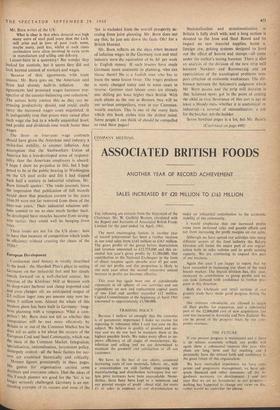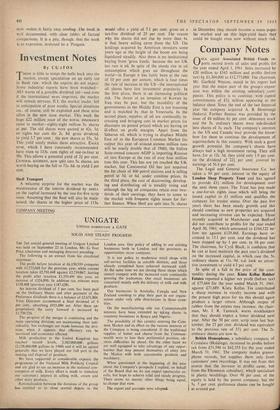Laisser-Faire to Joint Affair
DOUGLASS the Steelworkers' Union)
Fltom the very first page of his new book, Mr. Burn is provocative : 'Investment policies which give best results in the long run, do not win wars.' I wonder whether some of the in- vestment policies whicn have won wars would not give the best results in the long run. When Mr. Burn wrote his first book, to which this* is a sequel, we in Britain were experiencing slump and hopeless unemployment. My union was advocating rationalisation of the steel industry and less men per ton of output—not an easy text for a trade union leader in those days of dole queues and hunger marches, but an essential one. Yet the need to prepare for war proved to be the only impetus the industry responded to in the 1930s.
Whether any other impetus would have ulti- mately emerged is a matter for conjecture. Nationalisation had not attracted the electorate, and company directors were too traditionally self-sufficient to pool orders and efforts for rationalised operation. The industry had, there- fore, drifted into apathetic helplessness. 1, per- sonally, was informed by my management at the time that my members could not expect the plant on which I worked to operate at more than 33f per cent. capacity for the next three years at least.
Even an influx of accountants, each carrying a red light in one hand and a green one in the other, found the decision faculties of employers so paralysed that—with a few exceptions—they did not know their right hand from their elbow. Only the dark shadows of coming war proved capable of bringing out the necessary funds for the badly% needed development and, simul- taneously, providing a market for the industry's products.
It was in this atmosphere that Mr. Burn wrote his first book, a probing shaft of light in a dark
* The Steel Industry. By Duncan Burn. (C.U.P., 80s.) Anti-Trust and American Steelmaking
This section is not a little complicated but it describes in some detail methods of 'trust-bust- ing' operating in the US. Some scepticism m:1Y be permitted on whether trusts really are busted. This alleged competitive system with so-called customer advantage of low prices produced re- markably handsome balance sheets recently for steel firms in the US operating at 50 per cent. capacity, or less. world, historically objective, factual, closely argued. Superseded by war preparations, its facts and conclusions went unheeded, its criticisms unanswered; it was relegated to the bookshelf, even the dustbin, as a token of what many thought was a forgotten era. Yet its place in any history of British steel and its problems is un- challenged.
Has his new book come out at a repetitive period in history? Is our economic future any more secure? There are, at least, similarities in the problems of 1925-35 and those which shadoW our present industrial outlook. The general pic- ture in British steel today is one of restricted demand and output. The July output of steel was 3 per cent. down on a year ago; the August out- put was 84,500 tons a week less than in August, 1960, a reduction of 20 per cent. We are operat- ing at a reduced percentage of capacity of 65 per cent. against nearly 100 per cent. a short time ago. Scotland, as usual, is worst hit; every melting shop is below capacity, Scottish weeklY average output in August this year being only 40,100 tons against 50,800 tons for August, 1960. But throughout Great Britain older mills are closing and many modern mills are on short time.
Against such a background this new book provides food for thought, covering as it does such a wide range: the US, Europe and ourselves over the past twenty years. Mr. Burn writes of the US: What is clear is that when demand was high many users of steel paid more than the f.o.b. mill price and in time of poor trade some, maybe many, paid less, whilst at such times steelmakers were often involved in extra costs in manufacture and selling and delivery. Laisser-faire in a quandary! No wonder they looked for controls; but it seems they did not look beyond control of workers and wages. 'Because of their agreements with trade unions.' Mr Burn goes on, 'the American steel firms had already built-in inflation the agreements had promised wages increases irre- spective of the counter-balancing cost reduction.' The unions hotly contest this as they say in- creasing productivity should, and could, easily carry the increased wages costs negotiated. It Is indisputably true that prices were raised after each wage rise but to a wholly unjustified level; and profits and dividends rose much faster than wages.
The three- or four-year wage contracts Should have given the American steel industry a strike-free stability, to counter inflation. Any assumption that the Steelworkers Union of America has a less-developed sense of responsi- bility than the American employers is absurd. I hope I show no prejudice in this, but I hap- pened to be at the public hearing in Washington on the US steel strike and felt I had slipped back half a century in industrial relations. Mr.
Burn himself quotes: 'The trade journals leave the impression that publication of lull records Would show that practices current in the years 1946-59 were not far removed from those of the Inter-war years.' Their industrial relations atti- tude seemed to me to date much farther back.
So developed have muscles become from strong- arm tactics, they could well be hanging from trees.
These issues are not for the US alone: how lo have that measure of competition which leads to efficiency without creating the chaos of the 192.0s'?
European Development Continental steel history is vividly described In the book : the Marshall Plan's place in setting Germany on her industrial feet and her steady March forward on a well-charted course; her erection of the KlOckner Mill at Bremen with Its deep-water harbour and cheap imported coal and even cheaper oil; an anticipated output of 2.5 million ingot tons per annum may now be- come 5 million tons. Almost the whole of this modern plant has been built in Germany--long- term planning with a vengeance. What a com- Petitor! Mr. Burn does not tell us whether this competition will be met more effectively by Britain in or out of the Common Market but he does tell us quite a lot about the success of the 1.1ropean Coal and Steel Community, which was the basis of the Common Market. Integration, sPecialisation, rationalisation, investment policy, monopoly control—all the basic factors for sue- are examined historically and critically. .Monnet figures prominently in these pages. His genius for organisation carried some doubters and overcame others. That the ideas of this French planner are good for the 'Six' is no longer seriously challenged. Germany is an out- Ilanding example of its success and none of the is excluded from the overall prosperity ac- cruing from joint planning. Mr. Burn does not say this; he just sets down the facts. Oh! for a British Monnet.
Mr. Burn reflects on the days when because of inflation wages in the Germany iron and steel industry were the equivalent of 6s. 8d per week in English money' If such lessons have made Germans more amenable to planning, who can blame them? He is a foolish man .vho has to learn the same lesson twice. Elie wages position is vastly changed today and in some cases in reverse. German steel labour costs are already one shilling per hour higher than British With such plants as the one at Bremen they will be our serious competitors, even in our Common- wealth markets. This is one of the many facts which this book etches into the dullest mind. Some people I can think of should be compelled to read these pages! Nationalisation and denationalisation in Britain is fully dealt with, and a long section is devoted to the Iron and Steel Board and its impact on raw material supplies, home v. foreign ore, pricing systems designed to level out the effect of booms and slumps—all come under the author's testing hammer There is also an analysis of the division of the new strip mill between Newport and Ravenseraig and an appreciation of the sociological problems tem- pers criticism of economic weaknesses. The dif- ference between the Solomon's judgment which Mr Burn quotes and the strip mill decision is that Solomon ncvel got to the point of cutting the child in two. Severance of this sort is apt to leave a, bloody mess whether it is anatomical or industrial—a reversal of rationalisation; a job for the butcher. not the builder.
Seven hundred pages is a lot, but Mr. Burn's
(Combined on page 490) style makes it fairly easy reading. Fhe book is well documented, with clear tables of factual comparisons. It is a pity, though, that the book is so expensive; it.should be a 'Penguin.








































 Previous page
Previous page